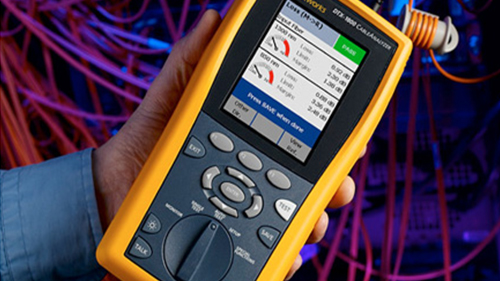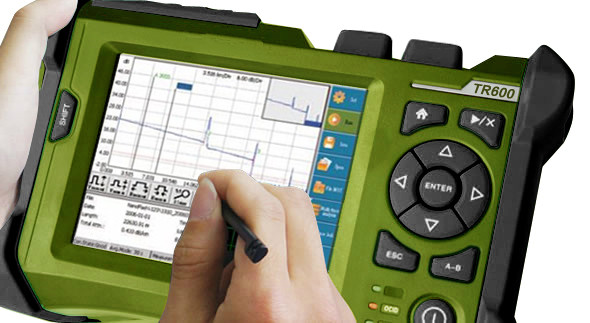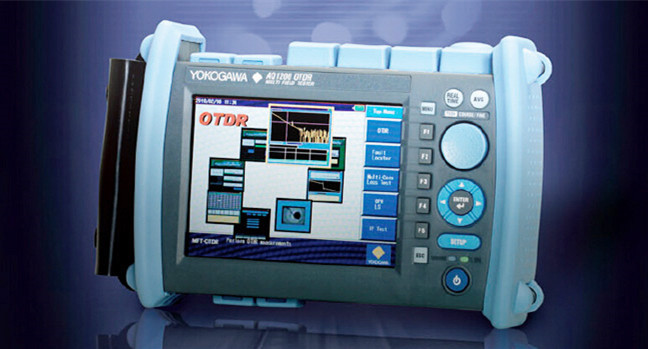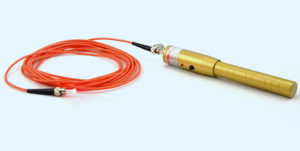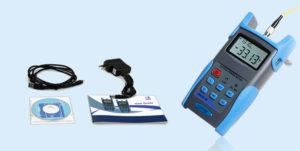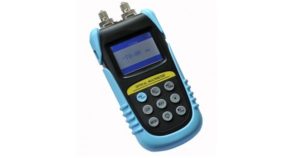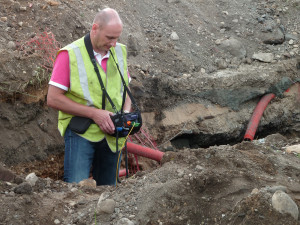It is easy to trouble shoot the failure which occurs on a point-to-point FTTx network by using an optical time domain reflectometer (OTDR) test. However, troubleshooting a faulty point-to-multipoint network (i.e., PON network) differs significantly and are more complex than a point to point network. This post will introduce the potential faults which may occur in a PON, and explain how to troubleshoot them with an OTDR.
Brief Introduction of PON
A PON (passive optical network) is a telecommunications network that uses point-to-multipoint fiber to the premises in which unpowered optical splitters are used to enable a single optical fiber to serve multiple premises. A basic PON (see Figure 1) consists of an optical line terminal (OLT) at the service provider’s central office and a number of optical network termination (ONT) or optical network units (ONUs) near end users. Sometimes, a second splitter can be connected in cascade to the first splitter to dispatch services to buildings or residential areas (see Figure 2). The International Telecommunications Union (ITU-T) and Institute of Electrical and Electronic Engineers (IEEE) have created several standards for optical access systems based on PON architecture (G.982, G.983 or G.984 for ITU and 802.3ah or 802.3av for IEEE).

Figure 1. Simple PON Topology

Figure 2. Cascaded PON Topology
Due to its architecture, operators can easily determine which subscribers are affected, and can also identify possible fault elements such as how many customers are affected and whether the PON is cascaded by using the network monitoring system at the Network Operation Center (NOC).
Possible Scenarios & Potential Faults of a PON
In general, we divide the faulty case of a PON as three scenarios. One case is that only one customer is affected. And the other case is occured in the cascaded PON and all affected customers are connected to the same splitter. The last case is all customers dependant on the same OLT are affected whether the PON is cascaded or not. In the first case, there are three probable potential faults. Fault may appear in the distribution fiber between the cutsomer and the closest splitter, or in the ONT equipment, or even appear in the customer’s home wiring. See Figure 3 (a) & (b).

Figure 3 (a). PON Case 1—Possible Faults When Only One Subscriber is Affected

Figure 3 (b). PON Case 1—Possible Faults When Only One Subscriber is Affected
When all customers connected to the same splitter cannot receive service, but others connected to the same OLT can, namely the second case, the cause may be that there is a fault at the last splitter or in the fiber link between the cascaded splitters. See Figure 4.

Figure 4. PON Case 2—Cascaded PON with Affected Subscribers Connected to Last Splitter
To the thrid case described above, if all customers are affected, the fault may occur in the splitter closest to the OLT, or in the feeder fiber/cable of the network, or directly in the OLT equipment, as the Figure 5 shown.

Figure 5. PON Case 3—All Subscribers are Affected (All Connected to the First Splitter)
In addition, we should know that if connectors are available at the splitters, terminals, or drops, isolating part of the faulty network will become easier. Inspecting connectors and taking OTDR measurements using 1310/1550 nm wavelengths are often performed on network sections that are out of service.
Why Use The Specific In-service Portable OTDR Device?
In order to troubleshoot PON networks in service, two dedicated tools are available — PON power meter and In-service 1625 or 1650 nm OTDR. As we know, a PON power meter is normally employed to verify that the signal is transmitted correctly to and from the ONT. A PON meter measures the power levels of all the signals and can then discriminate whether the issue comes from the customer’s ONT or from the network. However, you might be very confused with that why use In-service OTDR. The use of a classical OTDR with 1310 or 1550 nm test wavelengths would interfere with the traffic signals and disturb the traffic. At the same time, the traffic signals could also disturb the receiver of the OTDR, making it difficult to interpret OTDR traces. Due to mutual disturbances, classical OTDRs cannot be used, and specific in-service OTDRs are required.
The in-service OTDR was designed specifically for testing live fiber networks. This dedicated device uses an out-of band wavelength (test wavelength far away from traffic wavelength) to enable OTDR testing without disturbing either the network transmitters or the receivers. In the case of a PON network, WDM is no longer needed, except for monitoring purposes (using a remote fiber test system). The PON network is a point-to-multipoint configuration and the troubleshooting test is performed directly from an accessible element (ONT or splitter). The operator can disconnect the element because service is already off downstream toward the customer. First, the in-service OTDR must not disturb the other customers while shooting the OTDR test wavelength upstream toward the OLT, which is most likely the case, as OLTs reject signals above 1625 nm, based on ITU-T recommendations. Second, the traffic signals that the OTDR receives will be rejected to obtain accurate OTDR traces. The specific long-pass filter used to protect the OTDR diode can be added either via a jumper between the OTDR and the network or built into the OTDR.
Most equipment providers enable the use of the 1625 nm wavelength for safe testing. Some countries, such as Japan, are nevertheless pushing the 1650 nm wavelength as reflected in the ITU-T L.41 recommendation, which provides maintenance wavelengths on fiber-carrying signals. The 1650 nm wavelength is preferred based on the design of the filters and also because it is further away from the traffic signals (current and future PON technologies).
Case of PON Troubleshooting with OTDR
In order to make the whole troubleshooting or testing work smothly, it is essential to select the right OTDR tool, the correct pulse width, and the best location to start troubleshooting. OTDR configuration should be set according to the equipment being qualified and the distance to cover.
In response to the possible scenarios and potential faults of a PON described above, here are some solutions with OTDR to be introduced in the following. To avoid complexity, this document only analyzes the cases where connectors are only available at the ONT/OLTs.
Solution 1: Troubleshooting of the Distribution Fiber
Simple PON—Only one subscriber affected. Consider that no connectors are available at the splitter.(see Figure 6)
| Case |
Test Location |
OTDR Direction |
What must be Seen |
Comment |
Pulse Width to be use |
Specific OTDR |
| Case 1 one customer down |
Customer’s home Disconnect the ONT |
Upstream |
Distribution fiber up to the closest splitter |
Testing through the splitter is not required, as the issue is only on the disrtibution fiber side. |
Short pluse 3 to 30 ns |
In-service OTDR |

Figure 4. OTDR is Shot Upstream and Trace only Matters up to the Splitter
Solution 2: Troubleshooting of the Distribution Fiber and the Fiber between the Two Splitters in case of a Cascaded Network
All customers linked to the second splitter are down. Let’s consider the case where no connectors are available at the splitter.(See Figure 7.)
| Case |
Test Location |
OTDR Direction |
What must be Seen |
Comment |
Pulse Width to be use |
Specific OTDR |
| Case 2 all the customers are down after the second splitter |
Customer’s home Disconnect the ONT |
Upstream |
Distribution fiber up to the two splitters |
Testing through the closest splitter is required. |
Medium pluse 100 to 300 ns |
In-service OTDR – short dead zone |
This case requires viewing the signal after the splitter. The OTDR used must be optimized for this application and have the shortest possible dead zone as the splitter typically provides 7 to 10 dB loss.

Figure 5. OTDR is Shot Upstream and Trace should Display the Traffic through the Last Splitter up to the First One
Solution 3: Troubleshooting of the Feeder
Information received at the NOC shows that all customers are down. As the problem likely comes from the feeder side, the most common way to test the faulty network is to shoot an OTDR downstream from the OLT.(See Figure 8.)
| Case |
Test Location |
OTDR Direction |
What must be Seen |
Comment |
Pulse Width to be use |
Specific OTDR |
| Case 3 all customers are down |
OLT |
Downstream |
Feeder |
Testing through the splitter is unnecessary. |
Short pluse 3 to 30 ns |
Unnecessary |

Figure 6. OTDR is Shot Downstream and Trace should Display the Traffic Down to the First Splitter
Note: OTDR testing directly from the OLT is certainly the preferred choice when a faulty feeder is suspected (Solution 3), but this method is not recommended in the other cases.
Other PON Test Tools
Except the OTDR, there are some test tools used in PON troubleshooting in different phases, such as PON power meter, loss test set, IP testers (voice, data, video) and coaxial testers etc. Fiberstore can offer these test tools for you with high quality and competitive price. Such as ODTR, we can offer a variety of types of ODTRs in different brands, e.g. JDSU, YOKOGAWA. In addition, more PON related products can be found in Fiberstore. For more information, please visit our website or contact us over sales@fiberstore.com.

